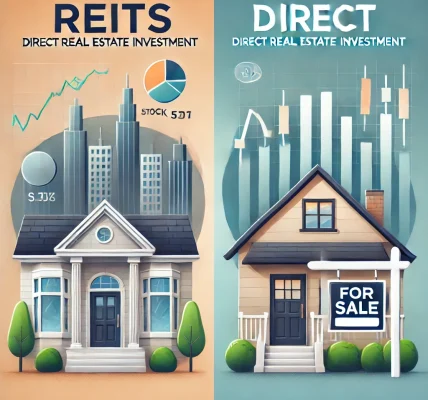Introduction
Investing in rental properties is a proven strategy for generating passive income, but one major decision investors face is:
Should you invest in vacation rentals (short-term) or long-term rentals?
✅ Vacation rentals (Airbnb, Vrbo, short-term stays) offer higher nightly rates but require more management and seasonal stability.
✅ Long-term rentals (traditional leasing, year-long tenants) provide consistent cash flow with fewer operational headaches.
So, which is more profitable in 2025 and beyond?
In this DIY guide, we’ll compare costs, profitability, risks, and management requirements to help you decide the best rental strategy for your investment goals.
1. Understanding the Basics of Each Rental Model
A. What Are Vacation Rentals?
Vacation rentals are short-term properties rented out on platforms like Airbnb, Vrbo, and Booking.com for a few nights to a few weeks.
✅ Ideal for tourist-heavy locations
✅ Higher nightly rental rates
✅ Requires active management (cleaning, bookings)
💡 Example: A beachfront condo in Miami rented on Airbnb for $250/night.
B. What Are Long-Term Rentals?
Long-term rentals involve leasing properties for months or years to a tenant. Renters sign a 12-month+ lease and pay monthly rent.
✅ Consistent, stable income
✅ Fewer management hassles
✅ Lower vacancy risk
💡 Example: A three-bedroom house rented for $2,000/month under a one-year lease.
2. Profitability Comparison: Vacation Rentals vs. Long-Term Rentals
A. Revenue Potential
✔️ Vacation Rentals:
- Higher per-night rates (e.g., $150-$300/night)
- Can generate 3-5x more income than long-term rentals
- Seasonal fluctuations impact revenue
✔️ Long-Term Rentals:
- Lower per-night rent (e.g., $1,500-$3,000/month)
- Steady monthly income with fewer vacancies
- Limited ability to increase rents frequently
Winner: Vacation rentals have higher income potential, but long-term rentals provide stability.
B. Expenses & Operating Costs
✔️ Vacation Rentals:
- Higher expenses (cleaning, utilities, furniture, maintenance)
- Marketing & platform fees (Airbnb charges ~3-15%)
- Higher property management fees (20-30% for a management company)
✔️ Long-Term Rentals:
- Lower maintenance costs (tenants cover utilities & minor repairs)
- No frequent turnover costs
- Lower property management fees (~8-12%)
Winner: Long-term rentals have lower expenses, making them more cost-efficient.
C. Occupancy Rates & Vacancy Risks
✔️ Vacation Rentals:
- High occupancy in peak seasons, but slow in off-seasons
- Properties in tourist locations may see 50-80% occupancy
- A single bad review can affect bookings
✔️ Long-Term Rentals:
- Consistently occupied (~95% in most markets)
- Lower vacancy risk due to lease agreements
Winner: Long-term rentals win for stability and lower vacancy risk.
D. Legal & Regulatory Risks
✔️ Vacation Rentals:
- Many cities have short-term rental restrictions
- Some areas require permits & additional taxes
- Noise complaints & HOA restrictions can cause issues
✔️ Long-Term Rentals:
- Subject to landlord-tenant laws (eviction process, lease terms)
- More predictable legal framework
- Rent control laws in some cities may limit profits
Winner: Long-term rentals offer a more predictable legal environment, reducing risk.
3. Which Rental Model is Right for You?
Choose Vacation Rentals If:
✅ You own property in a tourist-heavy location
✅ You can handle frequent management and maintenance
✅ You want to maximize short-term profits
✅ You’re comfortable with seasonal income fluctuations
Choose Long-Term Rentals If:
✅ You prefer steady, predictable monthly income
✅ You don’t want to deal with frequent turnover & bookings
✅ You want lower expenses and management involvement
✅ You’re investing in suburban or urban residential areas
4. DIY Guide: How to Start with Each Rental Model
A. Starting with Vacation Rentals
🔹 Step 1: Research high-tourism locations (beachfront, ski resorts, urban hotspots).
🔹 Step 2: Check local short-term rental laws & taxes.
🔹 Step 3: List on platforms like Airbnb & Vrbo with professional photos.
🔹 Step 4: Invest in furnishing & guest experience (WiFi, smart locks, concierge services).
🔹 Step 5: Use dynamic pricing tools to adjust rates based on demand.
💡 Pro Tip: Consider hiring a short-term rental manager if you don’t want to handle operations yourself.
B. Starting with Long-Term Rentals
🔹 Step 1: Choose a stable rental market with high job growth.
🔹 Step 2: Screen tenants carefully to avoid late payments & evictions.
🔹 Step 3: Set competitive rents based on local market trends.
🔹 Step 4: Hire a property manager (if needed) to handle leasing & maintenance.
🔹 Step 5: Monitor your property’s value and increase rent strategically over time.
💡 Pro Tip: Invest in multifamily units to maximize rental income from multiple tenants.
5. Final Verdict: Which Rental Model is More Profitable?
✔️ Vacation rentals generate higher income potential, but they require constant management and face seasonal risks.
✔️ Long-term rentals offer more stability, lower expenses, and fewer regulatory issues, making them ideal for passive investors.
👉 Best for cash flow maximization: Vacation Rentals
👉 Best for long-term stability & ease of management: Long-Term Rentals
6. Conclusion: Which Investment Should You Choose?
Both vacation and long-term rentals can be profitable depending on your investment style:
💰 If you want high short-term gains and are comfortable with active management, vacation rentals are for you.
🏡 If you prefer stable, hands-off income, long-term rentals are the smarter choice.
🎯 The best strategy? A mix of both—using vacation rentals in peak tourist seasons and converting to long-term rentals in the off-season.
🚀 Now it’s your turn! Which rental model are you considering? Drop your thoughts in the comments below!




